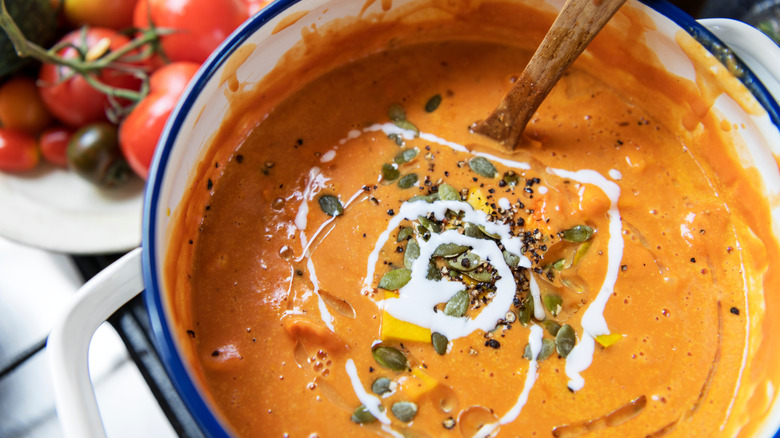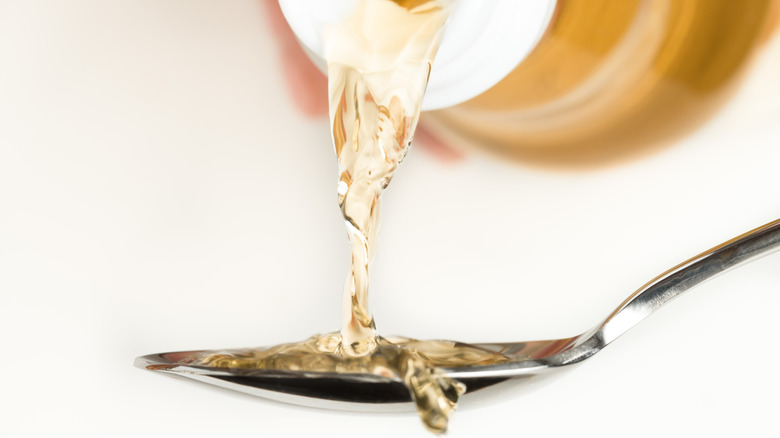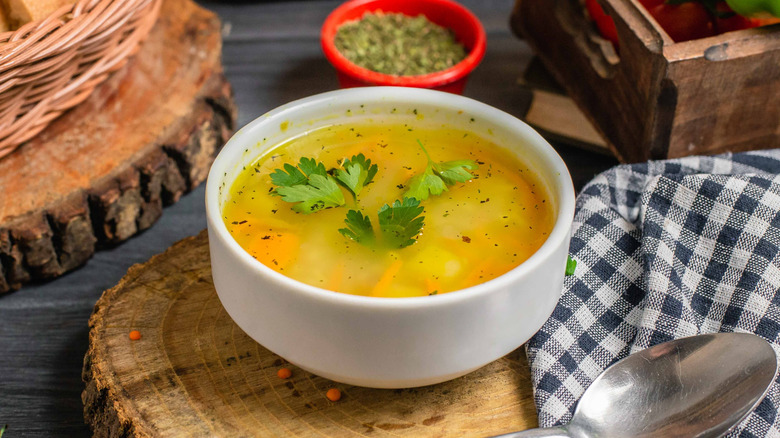How To Fully Upgrade Your Soup With One Ingredient
When the weather turns colder, there's one silver lining — soup season has officially arrived. Cozy and comforting, a warm bowl of soup is the perfect remedy for chilly evenings and flu season alike. From classic chicken noodle soup to tomato soup paired with a creamy grilled cheese, there's a soup for everyone. And with the right touches, even canned soup can be elevated with some simple upgrades. One ingredient that can take any soup — whether it's fresh or canned — to a whole new level is vinegar. Trust us — it's a game-changer! To learn more, Food Republic spoke with David Leite, founder of Leite's Culinaria.
According to Liete, cooks should add vinegar to soup because it brings balance. "Long-simmered soups can taste flat or heavy," he explained. "A small dose of acid makes everything taste more vividly like itself — salt seems saltier, sweetness reads cleaner, and umami pops." Acidic ingredients are well-known tools for brightening flavors of other ingredients — just think of how a squeeze of lemon transforms grilled meats or a vinaigrette, or how white wine is used to deglaze the pan for the perfect sauce base. Similarly, a dash of vinegar (which contains acetic acid) wakes up the ingredients in your soup, adding both depth and complexity. "The best time to add it is at the end, off the heat, or at the table," Leite advised. "Early drizzles of vinegar lose some of vinegar's bright, volatile top notes as they simmer."
Does vinegar affect the texture of soup?
Most vinegars are thin, being similar in texture to water (with some exceptions like aged balsamic), which means that they don't actually change the physical texture of the soup as starches or heavy cream would. According to David Leite, what it does change is the soup's perceived texture. By adding vinegar, "Rich soups feel lighter and less cloying," he explained. Take soups like lobster bisque or cream of mushroom, for example. Rich and delicious, they can quickly become too heavy after a few spoonfuls. With just a splash of vinegar, this richness is balanced out by sharper, brighter flavors, making them much more refined and satisfying without compromising their velvety body.
With all that being said, the acidic nature of vinegar can also negatively affect certain soups. "Acid slows the softening of beans, lentils, and vegetables," Leite told us. Boiling water tenderizes vegetables by breaking down their cell walls, but acid has the opposite effect, instead reinforcing the cell walls. This makes soups that rely on vegetables as their primary ingredients, such as minestrone or borscht, at risk of falling flat. The solution? "Add vinegar after they're tender to avoid tough skins or extended cook times," Leite advised.
Dairy-based soups also create unique challenges when paired with vinegar. Acid causes the proteins in dairy to break down, which is an instant recipe for curdling — think of milk splitting when it hits acidic coffee or a cream sauce that suddenly clumps up when lemon is added. No one wants their soup to have a grainy, curdled texture, so to prevent disaster, Leite recommends: "Add tiny amounts off the heat, or use higher-fat cream."
Best (and worst) soups for a splash of vinegar
There are countless styles of soups out there, and plenty of types of vinegar too. Some soups pair better with certain vinegars than others, so the key to success is finding the perfect match. "For big, brawny, rustic soups ... you need a vinegar that can stand up to it, like a red wine vinegar," David Leite told us. "For lighter, more vegetable- or chicken-forward soups, I go with white-wine vinegar." Think of it like pairing wine with food: a hearty red complements a rich steak, while a crisp white enhances lighter pasta or seafood dishes. The same logic applies to soup — it's all about aligning the character of the flavor profile of your soup. With that metric, "For earthy soups ... I reach for sherry vinegar," Leite told us. "It has a nutty, complex flavor that adds incredible depth." This makes it the logical match for nut-based soups like chestnut or walnut, whereas "apple cider vinegar is a natural fit for fall [purees] like butternut squash or pumpkin, or even a classic split pea," he added. Lastly, he suggested Chinese black vinegar for hot-and-sour soups as a nice balance.
But sometimes, vinegar isn't always the right finishing touch. "I'd never add it to a classic New England clam chowder," Leite told us. "The sweetness of the dairy and the brio of the briny clam juice are the whole point." There are also times when vinegar can overpower the very flavors that you're trying to brighten. "Skip it for soups that are already defined by a different acid," Leite told us — think soups that are built upon lime- or lemon-based broths like Tom Yum. While acid does wonders in small doses, too much will leave your soup with a one-note flavor: bitter.



